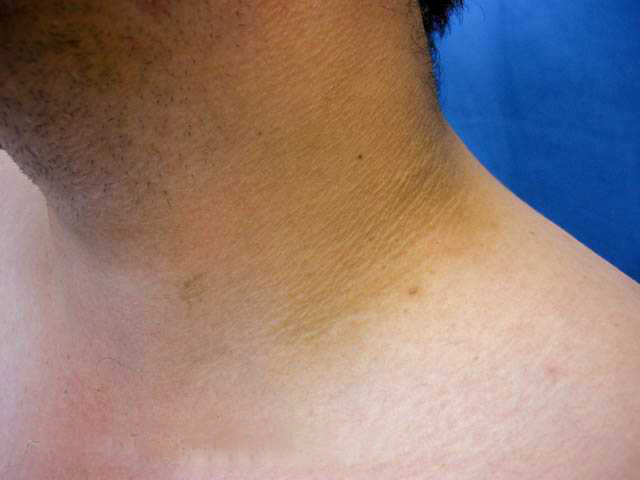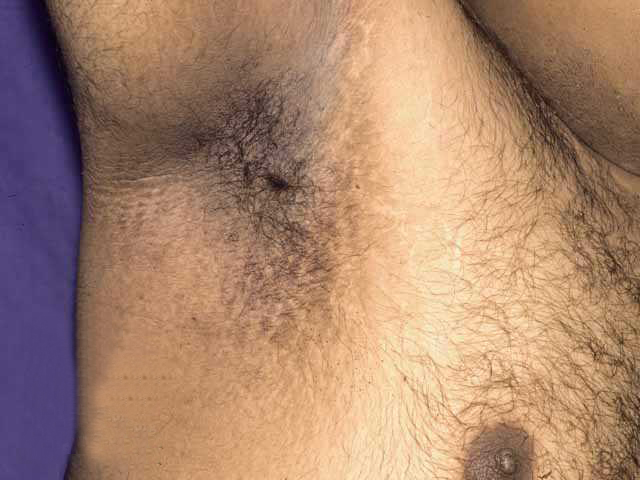Written by Dr. Pradeep
Acanthosis nigricans
What is acanthosis nigricans?
Acanthosis nigricans is a skin condition characterised by a velvety papillomatous overgrowth of the epidermis. Darkening and thickening (hyperkeratosis) of the skin occurs mainly in the flexural areas, particularly the axillae, groins, inframammary regions, and the neck.
Acanthosis nigricans is usually a sign of an underlying condition or disease, such as obesity or diabetes (benign). Its presence as a sign of internal malignancy is very rare.

Who gets acanthosis nigricans?
- Acanthosis nigricans affects < 1% of Caucasians. In the United States, the estimated prevalence is 13.3% of African Americans, 5.5% of Latinos, and 34.2% of Native Americans.
- It affects both males and females of all ages, with people < 40 years old typically being more affected.
- Acanthosis nigricans was found in 18.2% of children and 19.5% of adults in a cross-sectional study (n=1730) in the United States. Those diagnosed with acanthosis nigricans were twice as likely to have type 2 diabetes than those without (35.4% vs. 17.6%).
- Rarely, there is a link with an internal malignancy. Patients with malignant acanthosis nigricans tend to be middle-aged, not obese, and lesions develop abruptly.
What causes acanthosis nigricans?
The exact cause is still unclear, however it is predominantly linked to states of insulin resistance where obesity, diabetes, or metabolic disorders (eg, metabolic syndrome, polycystic ovary syndrome, generalised lipodystrophy) co-exist.

Insulin crosses the dermal–epidermal junction and, in high concentrations, can have growth-stimulating effects through its binding to type 1 insulin-like growth factor receptors (IGFRs) on keratinocytes. This stimulates the proliferation of these cells, leading to acanthosis nigricans.
What are the clinical features of acanthosis nigricans?
- Symmetric, thickened, brown, velvety patches and plaques of skin that appear:
1. Most commonly in the intertriginous areas: axillae, groin, and back of the neck
2.On the nipples, areolae, vulva, and perineum in women
3.On the mucous membranes of the oral cavity, nasal and laryngeal mucosa and oesophagus; these lesions tend to be greater in extent and severity in malignant acanthosis nigricans - Skin tags are common on cutaneous and mucosal surfaces
- Lesions may become macerated or malodorous
- Pruritus may be present and is very common in malignant acanthosis nigricans.

How do clinical features vary in differing types of skin?
- The skin may appear darker and leathery in darker skin phenotypes.
- People with skin phototype IV have a higher frequency of acanthosis nigricans on the neck compared to those with skin phototypes II and III.
- There is a very high certainty of insulin resistance in people with light skin that have acanthosis nigricans. However, in people with skin of colour, acanthosis nigricans can be present without concurrent insulin resistance. Therefore, the skin phenotype influences the likelihood of acanthosis nigricans being a predictor of insulin resistance.
What are the complications of acanthosis nigricans?
- Cosmetic disfigurement.
- Psychological distress.
- Acanthosis nigricans is an independent risk factor for the presence of diabetes.
- Complications associated with underlying disease, for example, obesity-associated complications.
How is acanthosis nigricans diagnosed?
- The diagnosis is made clinically, including a thorough history of current and past medical conditions, family history, and medications.
- If there is diagnostic uncertainty, a biopsy can be sent for histopathological analysis and confirmation.
- Abrupt onset in a thin individual should alert the physician to the possibility of an underlying malignancy; prompting an appropriate history, examination, and investigations.
What is the differential diagnosis for acanthosis nigricans?
- Confluent and reticulated papillomatosis: occurs more commonly in females with a mean age of 18–21 years. Reticulation is heterogenous instead of homogenous as seen in acanthosis nigricans. Pigmentation is not associated with peripheral reticulation in acanthosis nigricans.
- Erythrasma: characterized by well-demarcated red patches with possible scaling, found mainly in the intertriginous regions. A Wood lamp exam showing coral-red fluorescence is helpful in distinguishing it.
- Intertrigo: characterised by erythematous patches with possible pruritis and tenderness. It is nonspecific inflammation that is worsened by humidity. History of pruritus and morphology are helpful distinguishing features.
- Postinflammatory hyperpigmentation: this is localised and site-specific to the skin inflammation, and often there is a history of skin trauma or irritation.
- Tinea versicolor: hyperpigmented tinea versicolor presenting on the neck can be confused with acanthosis nigricans. Differentiation can be made by skin scale direct mycology.
What is the treatment for acanthosis nigricans?
The mainstay treatment is to manage the underlying disease. Patient education is also an important component.
General measures
- Non-pharmacological treatment can include lifestyle modifications such as a establishing a healthy diet, increasing exercise to help attenuate insulin resistance and hyperinsulinemia.
- Metformin and rosiglitazone have been used to reduce insulin levels and moderately improve the lesions.
- Malignant acanthosis nigricans should be managed with careful workup and management of the malignancy. Cyproheptadine can aid in the regression of acanthosis nigricans associated with malignancy because it inhibits the release of tumour-produced substances.
- Withdrawal of the suspected drug can help in resolving drug-induced acanthosis nigricans.
- Syndromic acanthosis nigricans can be improved with treatment of underlying syndrome. For example, use of oral contraceptives for polycystic ovary syndrome.
What is the outcome for acanthosis nigricans?
Outcomes depend on the cause. If the underlying etiology can be addressed eg, weight loss, then the acanthosis nigricans can resolve. Obesity, metabolic syndrome, and diabetes have deleterious effects on overall morbidity and mortality. Hereditary acanthosis may stabilise and even regress spontaneously in some cases. Malignant acanthosis nigricans is associated with a poorer prognosis (average survival time is 2 years) with early mortality often due to advanced cancer.
Related Procedures

Leg Hair Removal

Loyalty Rewards

Body Hair Removal

Facial Hair Removal

For Dark Skin

Threading

Alexandrite Laser

Electrolysis

